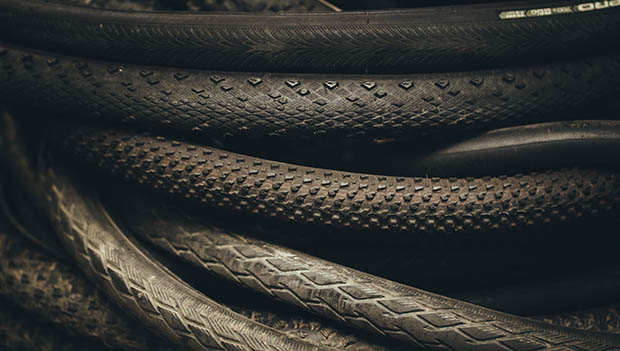
Just like road bikes themselves, road tires are not one size fits all.
While tires all look pretty much exactly the same to the untrained eye (especially when used and abused), there are some pretty big differences, not just between brands but between models as well. These differences should be taken into account as you start to race your bike, as well as for daily training rides where having the right tire is important for both handling and flat prevention.
To help, we're shining a light on one of the most overlooked pieces of gear—the humble road bike tire—by breaking down a handful of features and going over what to consider before you spend your hard-earned cash.
As always, the goal for riding a bike is to "keep the rubber side down," and having the right tire is the first step for doing so.
Let's get rolling.
Smooth vs. Treaded
Unlike mountain bikes where tires are covered in protruding knobby pieces of rubber designed to increase traction in the dirt, road bike tires are significantly more subtle when it comes to tread. Road bike tires come in both smooth and treaded varieties, with smooth tires designed exclusively to roll faster on clean pavement. Treaded road bike tires are a bit more versatile and can deal with some moisture, sand and road debris a bit better (recommended for areas with unpredictable weather). Road bike tires with tread are often slightly heavier, too, but are more durable than the slick alternative.
Tubeless vs. Tubed vs. Tubular
We know these all sound pretty much the same, but there are big differences between tubeless, tubed and tubular road bike tires.
Tubeless road bike tires are the most recent development in road bike tire technology—they're clincher tires that seal to the rim, allowing for lower tire pressure and better handling (and because there isn't a tube, they're lighter as well). They're also filled with liquid sealant, so if you roll over a nail or staple, the tire will reseal itself. This type of tire requires a tubeless-compatible wheel set, so be sure to check your rims before you make this investment.
Tubed road bike tires are the classic tires we all know and love. They're a tire that works with a clincher rim and requires an inner tube to inflate. These are easily serviceable, can be purchased just about anywhere and flats can be repaired quickly on the side of the road if you carry an extra tube or patch kit with you.
Tubular road bike tires are the least popular type of tire and are generally only used by professionals during races. The tire is glued directly to the rim, so they're lightweight and handle exceptionally well, but they're also tough to maintain and cost a lot more money.
Type of Rubber
Different rubber and synthetic compounds can dramatically change the overall feel and performance of a tire. Every brand will have a range of proprietary tire compounds ranging from those that are more durable (but generally less grippy and supple) for touring or commuting, all the way to race-ready compounds that may not last as long but have more elasticity.
Some companies have created a hybrid of the two for amateur cyclists looking for a longer-lasting tire with a bit more performance. This breakdown should be explained on the box of the tire in the store or in the description when buying online.
TPI
One specific metric to look at is a tire's TPI, or threads per inch. This is the casing below the rubber that helps hold the tire's shape once inflated, helps prevent flats or other damage to the tire itself and dictates the tire's rolling resistance. Long story short, the lower the TPI, the better the puncture resistance, but the higher the TPI, the smoother the ride.
Beyond TPI, some road bike tires also include other materials that protect the inner tube from being punctured (usually Kevlar). This often adds a bit more weight to the tire itself, but many go this route in favor of the added peace of mind.
Width
No matter the size of your rim, you'll be able to choose from a variety of tire widths that fit your rim. The most common width sizes for a standard road bike are 23 mm, 25 mm or 28 mm, and the trend lately has been to opt for larger, more versatile tires (even up to 32mm). Wider tires allow you to run at a lower PSI, meaning you'll have a more supple feel and have better traction. On the flip side, tires that are narrower are lighter and are more aerodynamic. Regardless of which width you pick, make sure the front and back tires match.
Also, if you're unsure what size tire is best for you, head over to your local bike shop for help deciding. Not all bikes have enough clearance for larger tires, so they'll help you find the right fit.
Ready to start shopping for new road bike tires? Head over to ACTIVE GearUp for steep discounts on top tire brands.
READ THIS NEXT: How to Tell When You Need to Replace Your Road Bike Tires


